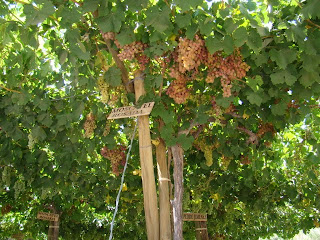,+Peru+027.JPG)
I was a stranger in a land that was new to me. I did not speak the language. Fortunately, I found my tribe right away. We don't need to speak to communicate.
We arrived in Lima, Peru, very early in the morning. We drove along the Pacific coast to the neighborhood of Miraflores, one of 24 districts in Lima. This seemed a well-do-do area. There are many colonial-time hourse tucked in amongst the modern hotels and skyscrapers. Our guide told us that, as the owners pass away, their children sell the old homes to developers. He said that probably in 10 years, none of these old homes will exist. I am glad I am here now to see them.
There was a large park with the ubiquitous cow exhibit going on. Beneath the park was a modern shopping area with restaurants, including sushi. As Peru is known for its excellent fresh seafood, and there is a sizable Japanese population here, this makes sense. Walking along the esplanade, I came to the Lovers' Park, where newly married couples come to have their photos taken beneath a large sculpture, and write their forever wishes in the ceramic walls surrounding the sculpture.
I found the steps to the beach, and walked the long way down to the surf tent. Although it is the Pacific, the water temperature was just right. Many people were in wet suits, but plenty of us chose to only wear rash guards. The waves were perfect, and there was so much room for everybody - a huge, wide open expanse of water. Of course, as the day went on, both the water and the bech got more crowded, so I am doubly glad we arrived early.
After this perfect beginning, we drove to the Seven Seas Mariner, in port at Callao, and boarded. Hey, it feels like coming home!
Overnight, we traveled 129 nautical miles, and docked in Pisco, Peru. To my surprise, this area looks like a desert. I've since found out that this is one of the driest areas on the planet. This dry coastline exists because the Humboldt current coming from Antarctica sucks away all the moisture.
Nevertheless, the months of January, February, and March are when the rivers are full, and there is a strong agricultural market here. pisco exports paprika, asparagus, and tangelos, as well as fish. In fact, fishing is the major idustry here, not tourism. Also, they export the mineral salt from this desert to Canada, for the purpose of melting ice and snow.
Peru has 9 National Preserves, and Paracas here in the state of Ica is one of them. The Paracas culture developed from 2500 B.C., preceding the Nascas, Juari, Cinca, and Inca cultures. In this Paracas Preserve, they have found more than 500 mummies from the time of the Paracas. So it makes me think there are similarities between this area and Egypt - the dependence on the river, and the knowledge of mummification. The Paracas also had monumental architecture, and trade items such as flutes made from pelican bones.
I learned that the Nascas culture is the one that created the lines on the ground that can be seen from outer space. There has been a lot of speculation as to the meaning of these lines (created by making stone walls), but our guide says the most reasonable explanation is that they were an astronomical calendar to asist with the agricultural planning.
The Incas, who I think we have all probably heard of, were the relative newcomers in 1533 A.D.
Again, these powerful and advanced cultures...and how little I know of South America, its culture and its history. Our storyteller, Terry Breen, believes that South America is poised to take a powerful position on the world stage.
Our destination as we traveled through this area were two wineries, one the oldest in Peru, and the other a neighborhood winery specializing in the national drink, Pisco, something like grappa. Again, passing through these lush fields of asparagus, paprika, and grape vines was somewht astonishing given the background of dry desert mountains.










,+Peru+041.JPG)
,+Peru+043.JPG)
,+Peru+053.JPG)
,+Peru+077.JPG)
,+Peru+027.JPG)
